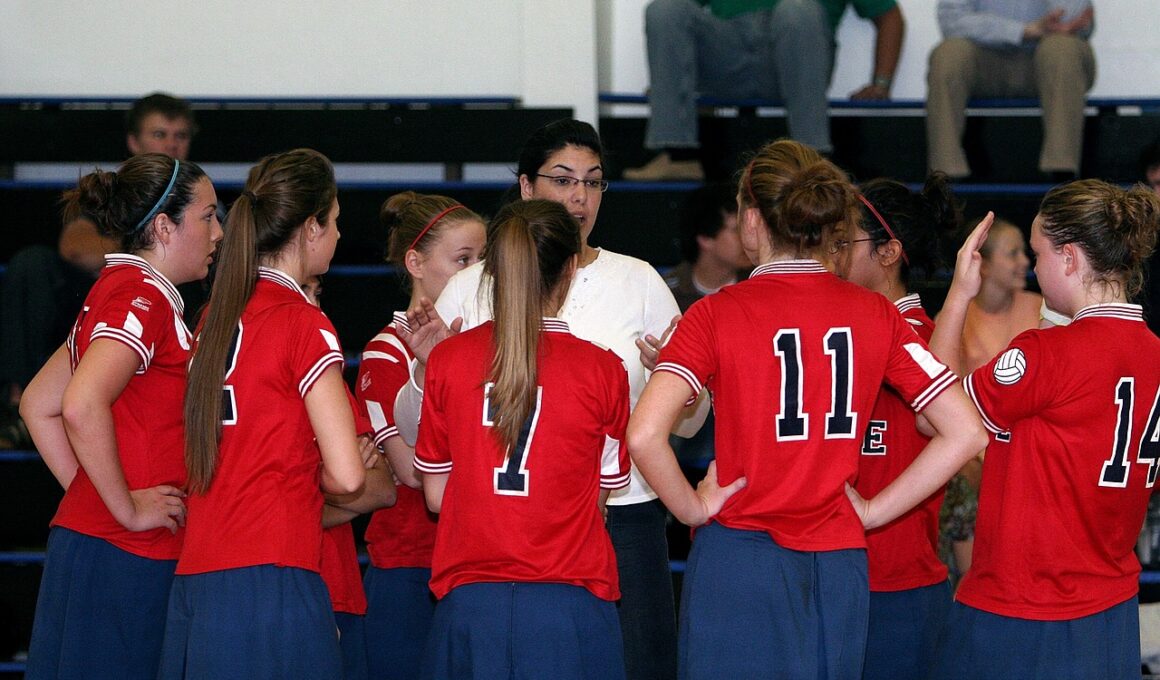Balancing Individual Talents and Team Needs in Volleyball Leadership
Leadership in volleyball encompasses a blend of understanding individual talents along with the overall needs of the team. Coaches and team captains must comprehend how to harmonize different skills and capabilities, ensuring that the best talent is utilized effectively. It is critical for leaders to evaluate each player’s strengths, ensuring everyone feels valued. This includes recognizing certain players, who may shine in specific roles, while others perfectly fit different needs on the court. Effective communication is vital; leaders must create an environment where players are comfortable discussing their abilities and goals. Mutual trust among players further encourages this open dialogue, creating opportunities for growth both individually and collectively. Concentrating on each player’s strengths leads not just to personal advancement but also to improved team performance. In volleyball, where strategies can shift frequently, leadership requires both strategic thinking and emotional intelligence. Leaders must remain adaptable, managing not just the play on the court but also the interpersonal dynamics within the team. Acknowledging individual talents while accommodating team needs leads to a balanced approach conducive to achieving shared objectives and success in competitions.
In addition to creating a positive environment, volleyball leaders must possess a keen sense of timing when employing strategies. Aligning individual skills with team dynamics involves more than just recognizing player strengths; it also requires tactical awareness of when and how to utilize those strengths during games. For example, a player with exceptional serving skills can turn the tide of a match, but they must also be in the right position at the right moment. Coaches may implement drills focused on honing these skills and integrating them into team strategies, thus elevating performance consistently. Regular assessments of individual growth and its impact on the team as a whole are essential. Leaders should provide constructive feedback that encourages players to refine their skills while emphasizing the importance of team cohesion. Reflection time post-game helps players understand their contributions in terms of both success and potential areas for improvement. Recognizing the collective effort ensures that everyone is pulled together in pursuit of a common goal. Understanding that each player is crucial to team success helps to mitigate tension and foster a collaborative atmosphere, ideal for collective achievements within the context of competitive play.
Developing a Collaborative Culture
Creating a culture of collaboration in a volleyball team is vital for integrating individual talents effectively. A successful leader fosters this environment by promoting unity among players. Through team-building exercises and inclusive practices, coaches and captains can enhance interpersonal relationships and encourage mutual support. Establishing clear team goals is essential; when players share a common objective, they are more likely to collaborate and lift each other, aligning their efforts. Communication plays a crucial role in this process, enabling team members to express concerns and foster an atmosphere of trust. Regular team meetings provide an ideal platform for discussing progress, sharing insights, and celebrating achievements. Moreover, implementing peer evaluation systems allows players to provide feedback on each other’s performances, spurring accountability and shared responsibility. This collaborative spirit doesn’t just enhance performance; it instills confidence, enabling players to take calculated risks and contribute their unique talents during matches. As players feel more connected, their willingness to support one another grows, which ultimately fortifies the entire team’s synergy on and off the court. A healthy balance between individual skills and team cohesion invariably leads to success.
Another fundamental aspect of volleyball leadership is recognizing and embracing diversity within the team. Every player brings their unique background, experiences, and skill sets, which can greatly enrich the team’s performance. It is important for leaders to understand and appreciate these differences, channeling diverse talents toward achieving team objectives. Coaches and captains can organize workshops or training sessions focused on embracing diversity and leveraging different perspectives. By encouraging players to share their individual stories and expertise, leaders foster an inclusive atmosphere where perspectives are valued. This can lead to innovative strategies that tap into each player’s strengths while addressing team needs. Moreover, appreciating diversity not only enhances team morale but also promotes respect among teammates, encouraging players to learn from one another. Creating an environment of mutual respect can effectively dissolve any potential biases or stereotypes. As leaders embrace each player’s contributions, they cultivate a sense of belonging that empowers individuals to perform at their best. Emphasizing both individual talents and collective goals ultimately results in a dynamic performance capable of overcoming stronger opponents throughout the season.
Emphasizing Continuous Improvement
In any volleyball training regimen, leaders must prioritize continuous improvement for both individuals and the team as a whole. This commitment to growth should not be seen as merely a cyclical process tied to game seasons; instead, it should be woven into daily practice routines. Establishing attainable but challenging goals encourages players to stretch their capabilities. Leaders can design specific drills targeting individual areas of improvement, while always contextualizing them to team strategies and needs. By setting benchmarks and milestone achievements, players gain a clearer understanding of their progress, enhancing motivation levels. Regular performance reviews can be tailored to focus on individual skills while helping the entire team recognize collective strengths and weaknesses. Additionally, fostering a mindset of resilience keeps players focused on improvement rather than allowing them to dwell solely on mistakes; it’s important that players see setbacks as learning opportunities. Leaders should model this mindset by displaying their own growth-based attitudes. This creates a powerful precedent that spreads throughout the team. Continuous improvement, both individual and team-based, ensures that every player contributes toward achieving their shared competitive aspirations.
Part of encouraging continuous improvement involves facilitating a growth mindset, which emphasizes that abilities can be developed through dedication and hard work. Volleyball leaders can encourage this mindset by providing an environment in which failure is not merely tolerated but also used as a tool for learning. When players see that mistakes can lead to constructive feedback, they become more open to taking risks on the court. Conducting post-game analyses can help teams discuss what went well. It also highlights challenges players faced during matches. By conducting reflective sessions, leaders can promote discussions that involve both individual and collective learning experiences. This reinforces an environment of support, enabling players to approach challenges head-on. Additionally, recognizing improvement through positive reinforcement can greatly enhance individual confidence. Acknowledging players’ efforts and celebrating small victories—which could range from mastering a new skill to improving teamwork—builds self-esteem. In fostering an appreciative culture among teammates, players find motivation in each other and continue contributing toward both personal and collective development. Support and validation play crucial roles in developing a winning attitude, leading teams toward remarkable success on and off the court.
The Role of Feedback in Development
Feedback is an essential element of effective volleyball leadership, directly contributing to both individual and team development. Constructive criticism and genuine praise are pivotal in helping players understand their areas of strength and potential growth. Leaders should strive to create a culture where feedback is frequently exchanged, empowering players to see it as an opportunity for improvement rather than criticism. Facilitating practice sessions incorporating peer evaluations promotes team bonding and communication, enabling players to share insights with one another. Establishing guidelines for providing feedback ensures that it stays respectful and constructive. Additionally, types of feedback can vary; verbal, written, or even video reviews can be utilized to help players understand their performances and make adjustments accordingly. Regular check-ins or feedback sessions help keep communication open and give players a chance to express any concerns. Moreover, leaders must also be receptive to receiving feedback from their players, creating a two-way street that fosters trust and communication. Emphasizing collaboration empowers players to take ownership of both their roles within the team and their growth as athletes, establishing a solid foundation for success and cohesiveness throughout the season.
Ultimately, effective volleyball leadership encompasses a variety of strategies designed to balance individual talents with team needs. This delicate equilibrium requires leaders to be adaptable, nurturing, and strategic in their approach to fostering the players’ growth. Understanding the importance of building strong relationships between players is crucial; it forms the backbone of a successful team. Leaders should be mindful of each player’s emotional and physical well-being, also serving as mentors who guide players toward achieving their full potential. Integrating individual objectives into broader team goals encourages collaboration; when players are aware their aspirations are aligned, they are more motivated to elevate their skill sets. Continuous learning, a culture of constructive feedback, and celebrating diversity all contribute to developing a well-rounded team capable of excelling in any competitive setting. Remembering that the pursuit of success is both a personal and collective journey helps cultivate a positive volleyball environment. As both individual and team progress are celebrated, bonds strengthen, ultimately leading towards championship achievements. Nurturing this balance is the essence of great volleyball leadership, making it a rewarding endeavor for leaders and players alike.


